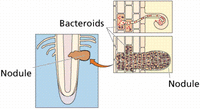This we have to see a bit deeper than what just visualy obvious for us.. As with so many things in nature, it follows some natural laws and always go towards the most favorable direction (direction of least resistance). For a plant as living thing there are more factors to it than only the consistency of the medium it grows in or on. For a plant with it's roots in the substrate it could be something else in the substrate preventing it to grow in a certain direction this could be anything e.g. affecting the soil to be less favorable, so it's grows in the other more favorable direction. Till that particalar spot becomes more favorable again. This all can happen on a level which is visualy not recognizable for us, there could be a number of things in the soil at that spot slowing root growth down in comparison to the other direction..
For an epiphyte growing on a piece of wood it kinda works the same way, the plant will grow in it's favorable direction. As you already state your self with this Anubias you see no obvious reason why it does. But still the plant is triggered somehow to grow faster in that direction rather than the other.
Now sceintist discovered that plants and their rootsystems work in symbiosis with some kind of bacteria in and around it's rhizoids.


For a epiphyte on a piece of wood the reason could be in that piece of (dead) wood. Visualy for us that piece of wood is consistend and looks the same all over. But on a microscopic level there probably are patches in this wood which are in consistency more favorable and containing a richer bacterial population the plant lives with. So there is more food fo the plant in that direction and the plant will rather grow faster towards that..
🙂
Soil we can replace, but with epiphytes on a piece of hardware this is rather difficult and we probably just need to let mother nature do it's thing. Even if you cut loos the plant and turn it around, it probably wont change it's favorite direction if that piece of wood in that direction yet is not ready enough for the plant to use it. The plant will keep growing faster in the direction where it gets the least recistance in this case. Not to say that the other direction never will be good, eventualy it might it's just a biological process which needs it's time.
This you can speed up as EnderUK says, cut a piece of rhizome or buy another nana and plant it in that spot, this might speed up that process...
🙂 Put some moss with it, could also speed up that symbiotic process..
If you look closely we see this happen all the time in our tanks and in nature. In hour tanks the first to show are usualy the algae.. I have one, growing algae film and all others yet don't.. Algae spores are all over, it's not just a matter of change algae spores landed on that spot..

And this is just one possible explanation there probably are many more..





